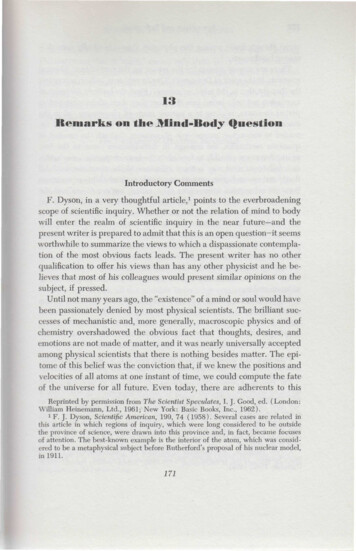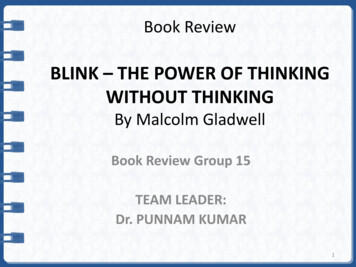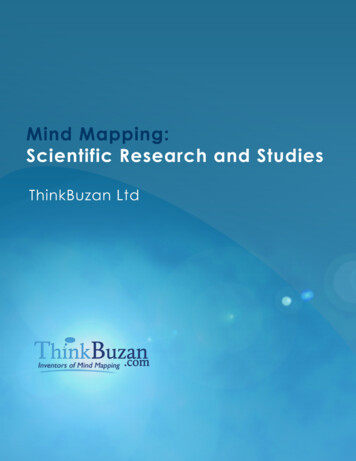
Transcription
13Remarks on the Mind-Body QuestionIntroductory CommentsF. Dyson, in a very thoughtful article, 1 points to the everbroadeningscope of scientific inquiry. Whether or not the relation of mind to bodywill enter the realm of scientific inquiry in the near future—and thepresent writer is prepared to admit that this is an open question—it seemsworthwhile to summarize the views to which a dispassionate contemplation of the most obvious facts leads. The present writer has no otherqualification to offer his views than has any other physicist and he believes that most of his colleagues would present similar opinions on thesubject, if pressed.Until not many years ago, the "existence" of a mind or soul would havebeen passionately denied by most physical scientists. The brilliant successes of mechanistic and, more generally, macroscopic physics and ofchemistry overshadowed the obvious fact that thoughts, desires, andemotions are not made of matter, and it was nearly universally acceptedamong physical scientists that there is nothing besides matter. The epitome of this belief was the conviction that, if we knew the positions andvelocities of all atoms at one instant of time, we could compute the fateof the universe for all future. Even today, there are adherents to thisReprinted by permission from The Scientist Speculates, I. J. Good, ed. (London:William Heinemann, Ltd., 1961;'New York: Basic Books, Inc., 1962).1F. J. Dyson, Scientific American, 199, 74 (1958). Several cases are related inthis article in which regions of inquiry, which were long considered to be outsidethe province of science, were drawn into this province and, in fact, became focusesof attention. The best-known example is the interior of the atom, which was considered to be a metaphysical subject before Rutherford's proposal of his nuclear model,in 1911.171
172Symmetries and Reflectionsview2 though fewer among the physicists than — ironically enough —among biochemists.There are several reasons for the return, on the part of most physicalscientists, to the spirit of Descartes's "Cogito ergo sum," which recognizesthe thought, that is, the mind, as primary. First, the brilliant successes ofmechanics not only faded into the past; they were also recognised aspartial successes, relating to a narrow range of phenomena, all in themacroscopic domain. When the province of physical theory was extended to encompass microscopic phenomena, through the creation ofquantum mechanics, the concept of consciousness came to the foreagain: it was not possible to formulate the laws of quantum mechanicsin a fully consistent way without reference to the consciousness.3 Allthat quantum mechanics purports to provide are probability connectionsbetween subsequent impressions (also called "apperceptions") of theconsciousness, and even though the dividing line between the observer,whose consciousness is being affected, and the observed physical objectcan be shifted towards the one or the other to a considerable degree, 4it cannot be eliminated. It may be premature to believe that the presentphilosophy of quantum mechanics will remain a permanent feature offuture physical theories; it will remain remarkable, in whatever wayour future concepts may develop, that the very study of the externalworld led to the conclusion that the content of the consciousness is anultimate reality.It is perhaps important to point out at this juncture that the questionconcerning the existence of almost anything (even the whole externalworld) is not a very relevant question. All of us recognize at once howmeaningless the query concerning the existence of the electric field invacuum would be. All that is relevant is that the concept of the electric2The book most commonly blamed for this view is E. F. Haeckel's Weltratsel( 1 8 9 9 ) . However, the views propounded in this book are less extreme (thoughmore confused) than those of the usual materialistic philosophy.3W. Heisenberg expressed this most poignantly [Daedalus, 87, 99 (1958) ]: "Thelaws of nature which we formulate mathematical!)' in quantum theory deal no longerwith the particles themselves but with our knowledge of the elementary particles."And later: "The conception of objective reality . . . evaporated into the . . . mathematics that represents no longer the behavior of elementary particles but ratherour knowledge of this behavior." The "our" in this sentence refers to the observerwho plays a singular role in the epistemology of quantum mechanics. He will bereferred to in the first person and statements made in the first person will alwaysrefer to the observer.4J. von Neumann, Mathematische Grundlagen der Quantenmechanik(Berlin:Julius Springer, 1932), Chapter VI; English translation (Princeton, N.J.: PrincetonUniversity Press, 1955).
Remarks on the Mind-Body Question173field is useful for communicating our ideas and for our own thinking.The statement that it "exists" means only that: (a) it can be measured,hence uniquely defined, and (o) that its knowledge is useful for understanding past phenomena and in helping to foresee further events. It canbe made part of the Weltbild. This observation may well be kept inmind during the ensuing discussion of the quantum mechanical description of the external world.The Language of Quantum MechanicsThe present and the next sections try to describe the concepts interms of which quantum mechanics teaches us to store and communicate information, to describe the regularities found in nature. Theseconcepts may be called the language of quantum mechanics. We shallnot be interested in the regularities themselves, that is, the contentsof the book of quantum mechanics, only in the language. It may be thatthe following description of the language will prove too brief and tooabstract for those who are unfamiliar with the subject, and too tediousfor those who are familiar with it.5 It should, nevertheless, be helpful.However, the knowledge of the present and of the succeeding section isnot necessary for following the later ones, except for parts of the sectionon the Simplest Answer to the Mind-Body Question.Given any object, all the possible knowledge concerning that objectcan be given as its wave function. This is a mathematical concept theexact nature of which need not concern us here—it is composed of a(countable) infinity of numbers. If one knows these numbers, one canforesee the behavior of the object as far as it can be foreseen. More precisely, the wave function permits one to foretell with what probabilitiesthe object will make one or another impression on us if we let it interactwith us either directly, or indirectly. The object may be a radiation field,and its wave function will tell us with what probability we shall see a5The contents of this section should be part of the standard material in courseson quantum mechanics. They are given here because it may be helpful to recallthem even on the part of those who were at one time already familiar with them, because it is not expected that every reader of these lines had the benefit of a course inquantum mechanics, and because the writer is well aware of the fact that mostcourses in quantum mechanics do not take up the subject here discussed. See also,in addition to references 3 and 4, W. Pauli, Handbuch der Physik, Section 2.9,particularly page 148 (Berlin: Julius Springer, 1933). Also F. London and E. Bauer,La Theorie de I'observation en mecanique quantique (Paris: Hermann and Co.,1939). The last authors observe (page 4 1 ) , "Remarquons le role essential que jouela conscience de 1'observateur. . . ."
174Symmetries and Reflectionsflash if we put our eyes at certain points, with what probability it willleave a dark spot on a photographic plate if this is placed at certainpositions. In many cases the probability for one definite sensation will beso high that it amounts to a certainty—this is always so if classical mechanics provides a close enough approximation to the quantum laws.The information given by the wave function is communicable. Ifsomeone else somehow determines the wave function of a system, hecan tell me about it and, according to the theory, the probabilities forthe possible different impressions (or "sensations") will be equally large,no matter whether he or I interact with the system in a given fashion.In this sense, the wave function "exists."It has been mentioned before that even the complete knowledge ofthe wave function does not permit one always to foresee with certaintythe sensations one may receive by interacting with a system. In somecases, one event (seeing a flash) is just as likely as another (not seeinga flash). However, in most cases the impression (e.g., the knowledge ofhaving or not having seen a flash) obtained in this way permits one toforesee later impressions with an increased certainty. Thus, one may besure that, if one does not see a flash if one looks in one direction, onesurely does see a flash if one subsequently looks in another direction.The property of observations to increase our ability for foreseeing thefuture follows from the fact that all knowledge of wave functions isbased, in the last analysis, on the "impressions" we receive. In fact, thewave function is only a suitable language for describing the body ofknowledge—gained by observations—which is relevant for predictingthe future behaviour of the system. For this reason, the interactionswhich may create one or another sensation in us are also called observations, or measurements. One realises that all the information which thelaws of physics provide consists of probability connections between subsequent impressions that a system makes on one if one interacts withit repeatedly, i.e., if one makes repeated measurements on it. The wavefunction is a convenient summary of that part of the past impressionswhich remains relevant for the probabilities of receiving the differentpossible impressions when interacting with the system at later times.An ExampleIt may be worthwhile to illustrate the point of the preceding sectionon a schematic example. Suppose that all our interactions with the system consist in looking at a certain point in a certain direction at times
Remarks on the Mind-Body Question175: . to 1, r0 2, , and our possible sensations are seeing or not seeinga flash. The relevant law of nature could then be of the form: "If yousee a flash at time t, you will see a flash at time t 1 with a probabilityl/4, no flash with a probability %; if you see no flash, then the nextobservation will give a flash with the probability %, no flash with aprobability *4; there are no further probability connections." Clearly,this law can be verified or refuted with arbitrary accuracy by a sufficiently long series of observations. The wave function in such a case depends only on the last observation and may be i//t if a flash has been seenat the last interaction, 2 if no flash was noted. In the former case, thatis for i/n, a calculation of the probabilities of flash and no flash afterunit time interval gives the values % and %; for i//2 these probabilitiesmust turn out to be % and %. This agreement of the predictions of thelaw in quotation marks with the law obtained through the use of thewave function is not surprising. One can either say that the wave function was invented to yield the proper probabilities, or that the law givenin quotation marks has been obtained by having carried out a calculation with the wave functions, the use of which we have learned fromSchrodinger.The communicability of the information means, in the present example, that if someone else looks at time t, and tells us whether he saw aflash, we can look at time t 1 and observe a flash with the same probabilities as if we had seen or not seen the flash at time t ourselves. Inother words, he can tell us what the wave function is: i/o if he did, i/ ifhe did not see a flash.The preceding example is a very simple one. In general, there aremany types of interactions into which one can enter with the system,leading to different types of observations or measurements. Also, theprobabilities of the various possible impressions gained at the nextinteraction may depend not only on the last, but on the results of manyprior observations. The important point is that the impression whichone gains at an interaction may, and in general does, modify the probabilities with which one gains the various possible impressions at laterinteractions. In other words, the impression which one gains at an interaction, called also the result of an observation, modifies the wave function of the system. The modified wave function is, furthermore, in general unpredictable before the impression gained at the interaction hasentered our consciousness: it is the entering of an impression into ourconsciousness which alters the wave function because it modifies our
176Symmetries and Reflectionsappraisal of the probabilities for different impressions which we expectto receive in the future. It is at this point that the consciousness entersthe theory unavoidably and unalterably. If one speaks in terms of thewave function, its changes are coupled with the entering of impressionsinto our consciousness. If one formulates the laws of quantum mechanicsin terms of probabilities of impressions, these are ipso facto the primaryconcepts with which one deals.It is natural to inquire about the situation if one does not make theobservation oneself but lets someone else carry it out. What is the wavefunction if my friend looked at the place where the flash might showat time t? The answer is that the information available about the objectcannot be described by a wave function. One could attribute a wavefunction to the joint system: friend plus object, and this joint systemwould have a wave function also after the interaction, that is, after myfriend has looked. I can then enter into interaction with this joint systemby asking my friend whether he saw a flash. If his answer gives methe impression that he did, the joint wave function of friend objectwill change into one in which they even have separate wave functions(the total wave function is a product) and the wave function of theobject is ipi. If he says no, the wave function of the object is /% i.e., theobject behaves from then on as if I had observed it and had seen noflash. However, even in this case, in which the observation was carriedout by someone else, the typical change in the wave function occurredonly when some information (the yes or no of my friend) entered myconsciousness. It follows that the quantum description of objects isinfluenced by impressions entering my consciousness.6 Solipsism maybe logically consistent with present quantum mechanics, monism inthe sense of materialism is not. The case against solipsism was given atthe end of the first section.The Reasons for MaterialismThe principal argument against materialism is not that illustrated inthe last two sections: that it is incompatible with quantum theory. The6The essential point is not that the states of objects cannot be described by meansof position and momentum co-ordinates (because of the uncertainty principle).The point is, rather, that the valid description, by means of the wave function, isinfluenced by impressions entering our consciousness. See in this connection the remark of London and Bauer, quoted above, and S. Watanabe's article in Louis deBroglie, Physicien et Penseur (Paris: Albin Michel, 1952), p. 385.
Remarks on the Mind-Body Question177principal argument is that thought processes and consciousness are theprimary concepts, that our knowledge of the external world is the content of our consciousness and that the consciousness, therefore, cannotbe denied. On the contrary, logically, the external world could bedenied—though it is not very practical to do so. In the words of NielsBohr,7 "The word consciousness, applied to ourselves as well as to others,is indispensable when dealing with the human situation." In view ofall this, one may well wonder how materialism, the doctrine 8 that "lifecould be explained by sophisticated combinations of physical and chemical laws," could so long be accepted by the majority of scientists.The reason is probably that it is an emotional necessity to exalt theproblem to which one wants to devote a lifetime. If one admitted anything like the statement that the laws we study in physics and chemistryare limiting laws, similar to the laws of mechanics which exclude theconsideration of electric phenomena, or the laws of macroscopic physicswhich exclude the consideration of "atoms," we could not devote ourselves to our study as wholeheartedly as we have to in order to recogniseany new regularity in nature. The regularity which we are trying totrack down must appear as the all-important regularity—if we are to pursue it with sufficient devotion to be successful. Atoms were also considered to be an unnecessary figment before macroscopic physics wasessentially complete—and one can well imagine a master, even a greatmaster, of mechanics to say: "Light may exist but I do not need it inorder to explain the phenomena in which I am interested." The presentbiologist uses the same words about mind and consciousness; he usesthem as an expression of his disbelief in these concepts. Philosophersdo not need these illusions and show much more clarity on the subject.The same is true of most truly great natural scientists, at least in theiryears of maturity. It is now true of almost all physicists—possibly, butnot surely, because of the lesson we learned from quantum mechanics.It is also possible that we learned that the principal problem is no longerthe fight with the adversities of nature but the difficulty of understanding ourselves if we want to survive.7N. Bohr, Atomic Physics and Human Knowledge, section on "Atoms and Human Knowledge," in particular p. 92 ( New York: John Wiley & Sons, 1960).8The quotation is from William S. Beck, The Riddle, of Life, Essay in Adventures of the Mind (New York: Alfred A. Knopf, I 9 6 0 ) , p. 35. This article is aneloquent statement of the attitude of the open-minded biologists toward the questions discussed in the present note.
178Symmetries and ReflectionsSimplest Answer to the Mind-Body QuestionLet us first specify the question which is outside the province ofphysics and chemistry but is an obviously meaningful (because operationally defined) question: Given the most complete description of mybody (admitting that the concepts used in this description change asphysics develops), what are my sensations? Or, perhaps, with whatprobability will I have one of the several possible sensations? This isclearly a valid and important question which refers to a concept—sensations—which does not exist in present-day physics or chemistry. Whetherthe question will eventually become a problem of physics or psychology, or another science, will depend on the development of thesedisciplines.Naturally, I have direct knowledge only of my own sensations andthere is no strict logical reason to believe that others have similar experiences. However, everybody believes that the phenomenon of sensations is widely shared by organisms which we consider to be living. It isvery likely that, if certain physico-chemical conditions are satisfied, aconsciousness, that is, the property of having sensations, arises. Thisstatement will be referred to as our first thesis. The sensations will besimple and undifferentiated if the physico-chemical substrate is simple;it will have the miraculous variety and colour which the poets try todescribe if the substrate is as complex and well organized as a humanbody.The physico-chemical conditions and properties of the substrate notonly create the consciousness, they also influence its sensations mostprofoundly. Does, conversely, the consciousness influence the physicochemical conditions? In other words, does the human body deviate fromthe laws of physics, as gleaned from the study of inanimate nature? Thetraditional answer to this question is, "No": the body influences themind but the mind does not influence the body. 9 Yet at least two reasonscan be given to support the opposite thesis, which will be referred toas the second thesis.The first and, to this writer, less cogent reason is founded on the9This writer does not profess to a knowledge of all, or even of the majority of all,metaphysical theories. It may be significant, nevertheless, that he never found anaffirmative answer to the query of the text—not even after having perused the relevant articles in the earlier (more thorough) editions of the EncyclopaediaBritannica.
Remarks on the Mind-Body Question179quantum theory of measurements, described earlier in sections 2 and 3.In order to present this argument, it is necessary to follow my description of the observation of a "friend" in somewhat more detail than wasdone in the example discussed before. Let us assume again that the object has only two states, i/n and uV2. If the state is, originally, i/u, the stateof object plus observer will be, after the interaction, ij/1 X X i; if the stateof the object is i/»2, the state of object plus observer will be p2 X A2 afterthe interaction. The wave functions xi and X-' g l v e t n e state of the observer; in the first case he is in a state which responds to the question"Have you seen a flash?" with "Yes"; in the second state, with "No."There is nothing absurd in this so far.Let us consider now an initial state of the object which is a linearcombination a \f/1 B L of the two states i/n and i/»2. It then folloivs fromthe linear nature of the quantum mechanical equations of motion thatthe state of object plus observer is, after the interaction, a (aq X Xi) B(i//2 X X2 ). If I now ask the observer whether he saw a flash, he will witha probability a [2 say that he did, and in this case the object will alsogive to me the responses as if it were in the state t/n. If the observeranswers "No"—the probability for this is \B\2—the object's responses fromthen on will correspond to a wave function ov2. The probability is zerothat the observer will say "Yes," but the object gives the response whichi//2 would give because the wave function a (uVj X Xl ) B (\p X x2) of thejoint system has no ( /*,, X xi) component. Similarly, if the observer denieshaving seen a flash, the behavior of the object cannot correspond to x1because the joint wave function has no (i/n X x.,) component. All this isquite satisfactory: the theory of measurement, direct or indirect, islogically consistent so long as I maintain my privileged position as ultimate observer.However, if after having completed the whole experiment I ask myfriend, "What did you feel about the flash before I asked you?" he willanswer, "I told you already, I did [did not] see a flash," as the case maybe. In other words, the question whether he did or did not see theflash was already decided in his mind, before I asked him.10 If weaccept this, we are driven to the conclusion that the proper wave func10F. London and E. Bauer (op. cit., reference 5) on page 42 say, "II [l'observateur] dispose d'une faculte caracteristique et bien familiere, que nous pouvons appeler la 'faculte d'introspection': il peut se rendre compte de maniere immediate deson propre etat."
180Symmetries and Reflectionstion immediately after the interaction of friend and object was alreadyeither yq X X l or yq X x2 a n ( i not the linear combination a (yq X Xl ) B('/'2 X X2/- This is a contradiction, because the state described by the wavefunction a (yi X Xi) B (y2 X x2) describes a state that has propertieswhich neither yh X A i nor y2 X X2 has. If we substitute for "friend" somesimple physical apparatus, such as an atom which may or may not beexcited by the light-flash, this difference has observable effects andthere is no doubt that a (yj X Ai) /3 ( 2 X X2) describes the propertiesof the joint system correctly, the assumption that the wave function iseither /u X Xi or y2 X 2 does not. If the atom is replaced by a consciousbeing, the wave function a (yu X Xi) 8 ( 2 X 2) (which also followsfrom the linearity of the equations) appears absurd because it impliesthat my friend was in a state of suspended animation before he answeredmy question. 11It follows that the being with a consciousness must have a differentrole in quantum mechanics than the inanimate measuring device: theatom considered above. In particular, the quantum mechanical equations of motion cannot be linear if the preceding argument is accepted.This argument implies that "my friend" has the same types of impressions and sensations as I—in particular, that, after interacting with theobject, he is not in that state of suspended animation which correspondsto the wave function a (yq X Ai) ft ( 2 X X2). It is not necessary to seea contradiction here from the point of view of orthodox quantum mechanics, and there is none if we believe that the alternative is meaningless, whether my friend's consciousness contains either the impressionof having seen a flash or of not having seen a flash. However, to denythe existence of the consciousness of a friend to this extent is surely an11In an article which will appear soon [Werner Heisenberg und die Physikunserer Zeit (Braunschweig: Friedr. Vieweg, 1961)] G. Ludwig discusses thetheory of measurements and arrives at the conclusion that quantum mechanicaltheory cannot have unlimited validity (see, in particular, Section Ilia, also V e ) .This conclusion is in agreement with the point of view here represented. However,Ludwig believes that quantum mechanics is valid only in the limiting case of microscopic systems, whereas the view here represented assumes it to be valid for all inanimate objects. At present, there is no clear evidence that quantum mechanics becomes increasingly inaccurate as the size of the system increases, and the dividing linebetween microscopic and macroscopic systems is surely not very sharp. Thus, thehuman eye can perceive as few as three quanta, and the properties of macroscopiccrystals are grossly affected by a single dislocation. For these reasons, the presentwriter prefers the point of view represented in the text even though he does notwish to deny the possibility that Ludwig's more narrow limitation of quantum mechanics may be justified ultimately.
Remarks on the Mind-Body Question181 r.natural attitude, approaching solipsism, and few people, in their-carts, will go along with it.The preceding argument for the difference in the roles of inanimatervation tools and observers with a consciousness—hence for a viola . an of physical laws where consciousness plays a role—is entirely cogent- : long as one accepts the tenets of orthodox quantum mechanics in alltheir consequences. Its weakness for providing a specific effect of theconsciousness on matter lies in its total reliance on these tenets—a reliwhich would be, on the basis of our experiences with the ephemeralnature of physical theories, difficult to justify fully.The second argument to support the existence of an influence of theconsciousness on the physical world is based on the observation that wedo not know of any phenomenon in which one subject is influenced byanother without exerting an influence thereupon. This appears convincing to this writer. It is true that under the usual conditions of experimental physics or biology, the influence of any consciousness is certainlyverv small. "We do not need the assumption that there is such an effect."It is good to recall, however, that the same may be said of the relationof light to mechanical objects. Mechanical objects influence light—otherwise we could not see them—but experiments to demonstrate the effectof light on the motion of mechanical bodies are difficult. It is unlikelythat the effect would have been detected had theoretical considerationsnot suggested its existence, and its manifestation in the phenomenonof light pressure.More Difficult QuestionsEven if the two theses of the preceding section are accepted, verylittle is gained for science as we understand science: as a correlation ofa body of phenomena. Actually, the two theses in question are moresimilar to existence theorems of mathematics than to methods of construction of solutions and we cannot help but feel somewhat helplessas we ask the much more difficult question: how could the two thesesbe verified experimentally? i.e., how could a body of phenomena be builtaround them. It seems that there is no solid guide to help in answeringthis question and one either has to admit to full ignorance or to engagein speculations.Before turning to the question of the preceding paragraph, let us note
182Symmetries and Reflectionsin which way the consciousnesses are related to each other and to thephysical world. The relations in question again show a remarkable similarity to the relation of light quanta to each other and to the materialbodies with which mechanics deals. Light quanta do not influence eachother directly12 but only by influencing material bodies which then influence other light quanta. Even in this indirect way, their interaction isappreciable only under exceptional circumstances. Similarly, consciousnesses never seem to interact with each other directly but only via thephysical world. Hence, any knowledge about the consciousness of another being must be mediated by the physical world.At this point, however, the analogy stops. Light quanta can interactdirectly with virtually any material object but each consciousness isuniquely related to some physico-chemical structure through whichalone it receives impressions. There is, apparently, a correlation betweeneach consciousness and the physico-chemical structure of which it is acaptive, which has no analogue in the inanimate world. Evidently, thereare enormous gradations between consciousnesses, depending on theel
Remarks on the Mind-Body Question Introductory Comments F. Dyson, in a very thoughtful article,1 points to the everbroadening scope of scientific inquiry. Whether or not the relation of mind to body will enter the realm of scientific inquiry in the near future—and the present writer is










